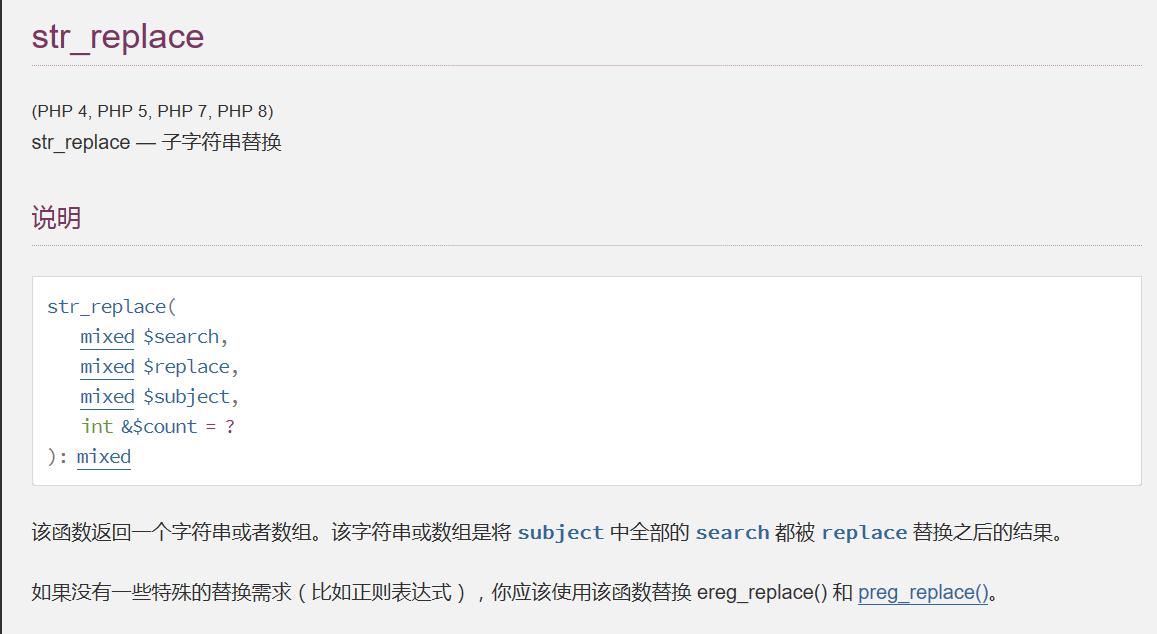4.1. 字符串常用函数
持之以恒,方得始终!
trim(), ltrim(), rtrim()
去除字符串左右两边的空格,或其它字符。
比如我们获取的数据要入库,或者和其它字符串做比较。
$name = trim($_REQUEST['name']);nl2br()
用html中的 <br/> 替换字符串中的 \n。
echo nl2br($mailcontent);echo, print(), printf(), sprintf(), vprintf(), vsprintf()
echo 输出,可以看作是一个语法结构,语法规定就是这么用的,不必深究。
print() 也是输出,和echo一样,不过它有返回值。
printf() 可以实现一些复杂的格式,也是直接输出。
sprintf() 和printf()一样,不过它不是直接输出了,是返回一个格式化后的字符串。
$total = 12.4;
echo "Total amount of order is $total. \n";
printf("Total amount of order is %s. \n", $total);
// Total amount of order is 12.4.
// Total amount of order is 12.4.
printf("Total amount of order is %.2f \n", $total); // Total amount of order is 12.40
$total_shipping = 100;
printf("Total amount of order is %.2f (with shipping %.2f)", $total, $total_shipping); // Total amount of order is 12.40 (with shipping 100.00)%s 表示这里需要用一个字符串来替换,从后面的参数中按所在顺序位置找。%.2f 表示这里需要一个精确到小数点后两位的浮点数来替换。
具体怎么用,我们看手册即可。常用的就是%d, %s, %f。
替换的参数,我们还可以手动指定,%2$,使用第二个参数。
$total = 12.4;
$total_shipping = 100;
printf("Total amount of order is %2$.2f (with shipping %1$.2f)", $total, $total_shipping);
//Total amount of order is 100.00 (with shipping 12.40)比如有参数重复情况下,就可以这样用了。
vprintf(), vsprintf() 第二个参数是接收数组,具体看手册。
strtoupper(), strtolower(), ucfirst(), ucwords()
strtoupper() 将字符串全部转为大写。
strtolower() 将字符串全部转为小写。
ucfirst() 将第一个字符,转为大写。
ucwords() 将字符串中的每个单词的首字母,转为大写。
addslashes(),stripslashes()
某些特殊字符,比如' " \ \\ null等等,如果不处理,直接入库,则会出现一些问题。
我们可以加转义字符\, 即变成 \' \" \\ \\\\ \null
$feedback = "tihs's very'goods\"idea"; // 一般是外部输入
$feedback = addslashes(trim($feedback));
print_r($feedback); // tihs\'s very\'goods\"idea如果我们的\多了,那么可能是php配置中的 magic_quotes_gpc 开启了。gpc表示 get,post,cookie。开启后,会自动加\。
我们可以用 get_magic_quotes_gpc() 函数,检查是否启用了。
stripslashes() 是移除\, 比如我们输出到html中,就需要移除了。
一般我们建议根据DB,选择其自己的转义函数,比如mysql的mysqli_real_escape_string()
explode(),implode()
explode() 将字符串按指定的分隔符,分割为一个数组。explode(string $separator, string $string, int $limit = PHP_INT_MAX): array
第三个参数,表示分割的数量。
$email = "hello@163.com";
$email_arr = explode('@', $email);
print_r($email_arr);
/* Array
(
[0] => hello
[1] => 163.com
) */
if(strtolower($email_arr[1]) == 'bigcustomer.com') { // 看到没,这里就把接收进来的字符串转为小写,因为我们不知道用户输入的情况。
$toaddress = "bob@example.com";
} else {
$toaddress = 'feedback@example.com';
}implode() 将数组中的值,按指定的符号,组合为一个字符串。
$arr = ['bob','example.com'];
$str = implode('@', $arr);
print_r($str); // bob@example.comstrtok()
也是分割字符串,和explode()一次全部分割好不一样,strtok()是一次只从字符串中取出一个片段。
$string = "This is\tan example\nstring";
$tok = strtok($string, " \n\t");
while ($tok !== false) {
echo "Word=$tok<br />";
$tok = strtok(" \n\t");
}substr()
从字符串中截取部分。直接看例子:
$test = "your customer service is excellent";
echo substr($test, 1) . PHP_EOL; // our customer service is excellent
echo substr($test, -9) . PHP_EOL; // excellent
echo substr($test, 0, 4) . PHP_EOL; // your
echo substr($test, 5, -13); // customer service对于有中文的截取,我们可以用 mb_substr()。
字符串的排序比较
strcmp(), strcasecmp(), strnatcmp(), strnatcasecmp()
strcmp($str1, $str2), 如果两个字符串相等,返回0;如果按字典顺序,str1在str2后面,即str1大于str2,返回正数。如果str1在str2前面,即str1小于str2 ,返回负数。这个函数区分大小写。
$str1 = "Hello";
$str2 = "hello";
var_dump(strcmp($str1, $str2)); // H < h , 即 $str1 < $str2, 返回 -1strcasecmp() 和 strcmp()一样,但是不区分大小写。
$str1 = "Hello";
$str2 = "hello";
var_dump(strcasecmp($str1, $str2)); // int(0)strnatcmp(), strnatcasecmp() 是按自然顺序对比排序的,比如 '2'是排序大于'12', 因为 '2' 大于 '1'; 自然排序,则是按人的习惯, '2' < '12' 。
var_dump(strnatcmp(2, 12)); // int(-1)strlen()
返回字符串的长度
if(strlen($email) < 6) {
echo "email error";
}匹配 strstr(),stristr(),strrchr()
比如,我要在反馈文本中,搜索shop字符串,可以用 explode(), strtok(), 在文本中检索每个单词,然后用 ==, 或 strcmp() 进行比较。当然下面的函数更好用。
strstr()
$email = 'name@example.com';
$domain = strstr($email, '@');
echo $domain; // @example.com
$toaddress = "feedback@example.com";
if(strstr($feedback, 'shop')) {
$toaddress = "retail@example.com";
} else if(strstr($feedback, 'delivery')) {
$toaddress = 'fulfillment@example.com';
}stristr() 和strstr()一样,但不区分大小写。
strrchr() 和 strstr() 一样,但是,是从最后匹配到地方开始算。
$email = 'name@example.com@123';
$domain = strrchr($email, '@');
echo $domain; // @123这三个函数,匹配到后,都是返回剩余字符串。
查找子字符串的位置 strpos(),strrpos()
strpos() 返回第一次匹配到的位置
$test = 'Hello world ';
echo strpos($test, "o"); // 4
echo strpos($test, "o", 5); // 7, 第三个参数5,表示从位置5开始搜索strrpos() 返回最后一次匹配到的位置
$test = 'Hello worlod ';
echo strrpos($test, "o"); // 10如果匹配不到,它们都返回false,但是假如匹配到的位置是0,那么 false == 0,是对的,这样判断就有问题了,我们可以用 ===
$test = 'Hello worlod ';
$res = strpos($test, "H");
if($res === false) {
echo "没有搜索到目标字符";
} else {
echo "找到了,位于:" . $res;
}替换 str_replace(),substr_replace()

搜索第一参数,用第二个参数替换之,第三个参数是给的字符串,第四个参数是被替换的次数。
$feedback = str_replace($offcolor, '%!@*', $feedback);substr_replace() 选择字符串中的某一段进行查找替换。
$test = "hello world";
// 用 X 替换最后一个字符
$test = substr_replace($test, 'X', -1);
echo $test; // hello worlX还有第四个参数,可选的长度length,如果不给
如果 length 为0
如果是正数
如果是负数
如有任何侵权行为,请通知我删除,谢谢大家!
个人邮箱:865460609@qq.com

 读书笔记:《PHP和MySQL Web开发》
读书笔记:《PHP和MySQL Web开发》

 关于 LearnKu
关于 LearnKu




推荐文章: